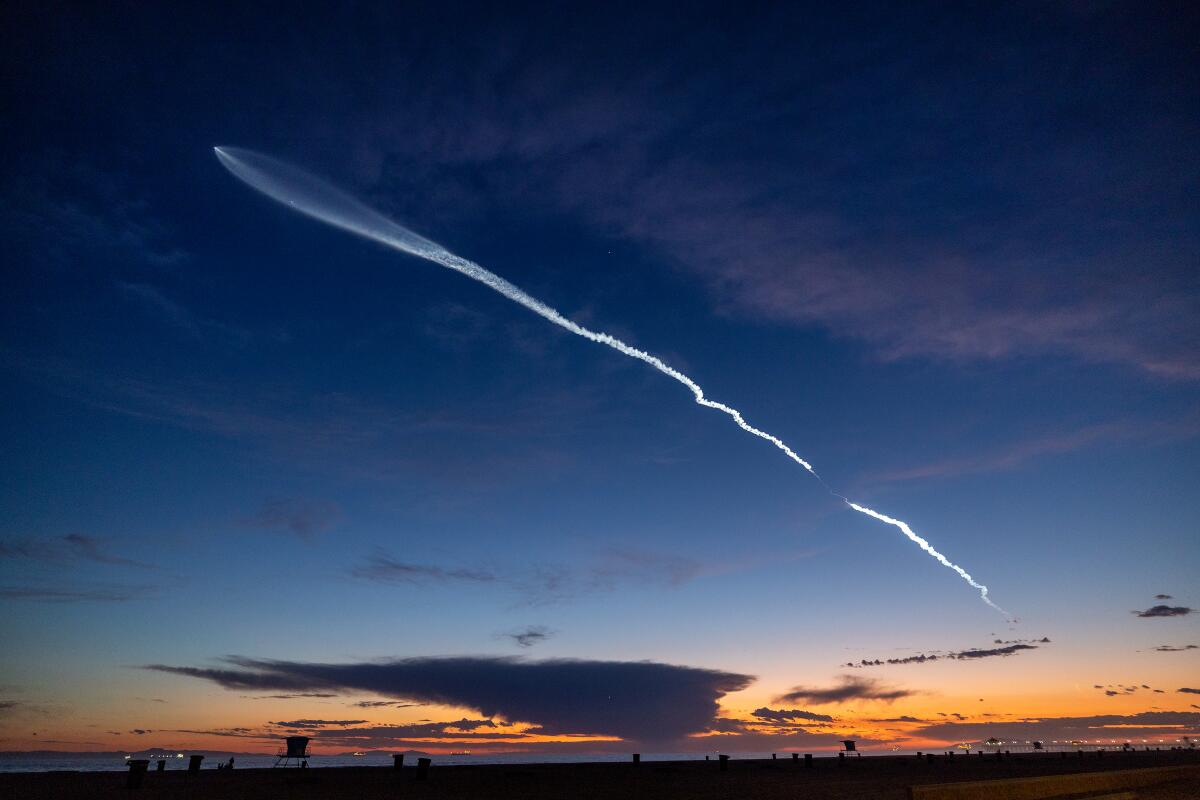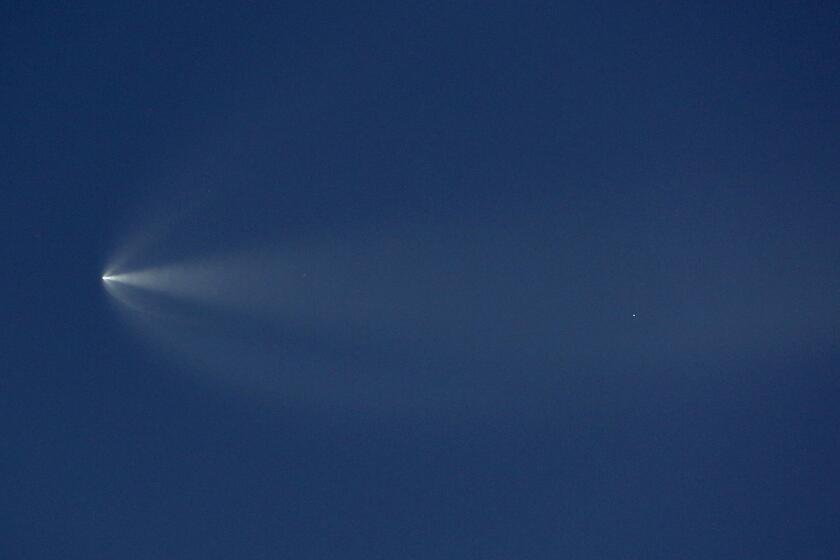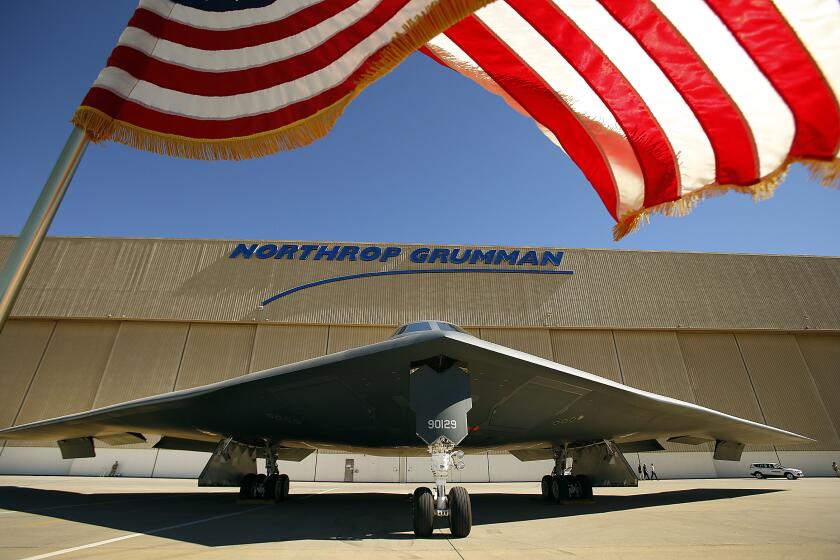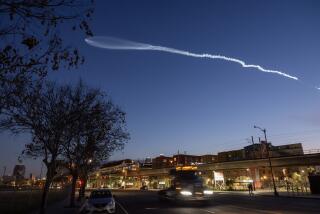SpaceX is launching more rockets from a military base. Can the Coastal Commission impose a limit?

- Share via
SpaceX has significantly increased the frequency of its rocket launches from a Santa Barbara County military base, and its plans to add even more have raised concerns by the California Coastal Commission over the impacts on the environment and nearby communities.
The company, officially Space Exploration Technologies Corp., owned by billionaire Elon Musk, has already breached an agreement between base officials and the coastal commission that limited the yearly launches from Vandenberg Space Force Base to six.
SpaceX has asked the commission for permission to launch up to 36 times per year from Vandenberg, as well as to conduct up to 12 landings a year at a second launch complex and an offshore landing spot in the Pacific Ocean.
Visible for miles around, the launches can create awe-inspiring spectacles as the aircraft hurtle up through the atmosphere, leaving behind a streak tracing the path of the rocket.
But nearer the base, the launches can force the closure and evacuation of nearby beaches and campgrounds, and residents have reported their windows shaking and rattling from the apparent sonic booms.
“It’s very stressful when you experience something like a sonic boom and you’re not expecting it,” said Phil Simon, a resident of Ojai for 25 years who spoke to the commission Wednesday. “I don’t know if the rockets being launched are different now, the trajectory is different, but something is different than how it was in the past.”
SpaceX launched a rocket from Vandenberg Space Force Base around 8 p.m. Monday after inclement weather postponed its launch last week.
The California Coastal Commission reviewed on Wednesday the request from the U.S. Space Force on behalf of the SpaceX projects and heard concerns from residents about the proposed increase in the number of launches. The panel also questioned whether the commission should practice more oversight over the launches.
But whether the commission even has the authority to limit the launches is unclear.
“We don’t allow roosters in this city, why can’t we regulate SpaceX?” Larry Steingold, an Ojai resident, asked the board.
Tasked with protecting the state’s coastal resources, the state agency regulates the use of land and water along the coast and can issue, or deny, permits for development. When it comes to imposing its will over federal agencies —such as the U.S. Department of Defense — the commission’s powers stop short.
The U.S. Space Force made the request on SpaceX’s behalf because the company launches equipment for the Department of Defense.
“[With] federal agencies it’s much more of a negotiation and a thing of equal powers dynamic,” Cassidy Teufel, deputy director of the commission, said during the meeting.
Federal agencies negotiate agreements with the commission about such plans, but ultimately, Teufel said, the commission’s approval is not required.
“If the commission were to reject, the federal agency could still decide to move forward,” he said.
Although SpaceX is a privately owned company, the Defense Department has argued that all the launches from Vandenberg — including those solely for the company’s benefit — are “federal agency activity” or done on behalf of the agency.
About 25% of SpaceX rocket launches from the base are carrying Department of Defense payloads, said Space Force Col. Bryan Titus, operations vice commander at the base.
Defense contractor Northrop Grumman told its employees that about 1,000 jobs could be cut in Southern California after lost a big satellite contract.
The vast majority of the rockets, however, are ferrying satellites into orbit to support SpaceX’s private Starlink network, which provides internet services.
Officials with SpaceX did not immediately respond to a request for comment.
Despite the private financial benefit to SpaceX, Titus argued that all of the rockets launched by the company were a benefit to the Defense Department, including its ability to rapidly increase its capacity to launch more rockets.
“I could argue that all launches that SpaceX does support the Department of Defense and our partners and allies,” he said during the meeting. “Starlink has been absolutely critical in the situation in Ukraine.”
“And to our enemies,” responded Commissioner Dayna Bochco. “Musk had a lot to say about that.”
Russia has banned the use of Starlink and the company has said it has denied giving the technology to Russia. Still, Ukrainian military officials have said Russian troops have been using the satellite network to communicate in the war.
Commissioners and residents noted the local impacts of the increasing number of launches from Vandenberg.
Rocket launches that shut down nearby Jalama Beach for safety reasons were limited by the commission to no more than 12 this year, but commission staff noted that number had been surpassed in the first seven months of 2023.
According to a staff report, SpaceX conducted 13 rocket launches in 2022, more than double the number that had been agreed to that year. The company also exceeded the number in 2023, with 28 launches, before it first reached out to the coastal commission in December for permission to increase the number to 36 per year.
Santa Barbara: Seven new cabins at Jalama Beach County Park
In exchange for allowing more launches, SpaceX has proposed placing internet terminals at Jalama Beach, which could help manage reservations and notify visitors when an evacuation could occur.
The company has also proposed adding a messaging sign on the road leading to the beach to notify visitors of a closure ahead, saving some visitors about a 45-minute drive.
Under the agreement, the Department of Defense has also proposed providing a shuttle to ferry visitors out of the beach during evacuations.
But commissioners expressed concern about the overall number of launches from the base in coming years, not just by SpaceX but also by other companies working with the military.
Last year, 37 launches were conducted at the base, Titus said.
“This year I wouldn’t be surprised if we got closer to 50,” he said, adding that the Space Force expects the number to increase in the coming years.
The U.S. Fish and Wildlife Service has studied the potential impacts to wildlife in the area and, according to Titus, has cleared the base for up to 110 launches a year without an adverse effect on nearby animal life.
“We’re not going to get to 100 launches any time soon, but I don’t think we’ve been shy saying that’s where we want to go,” he said.
If no agreement is reached, staff said, the Department of Defense could decide to move forward regardless. The commission could also decide to pursue the matter in mediation or in court.
The court found that X Corp.’s lawsuit was about punishing the watchdog group’s speech for criticizing the social media platform.
Commissioners delayed the vote to approve the agreement with SpaceX by a month, and instead asked staff to look at the possibility of separating SpaceX launches from military and private use, and studying the cumulative impact of increased launches at the base.
At about the same time, SpaceX announced that another of its Falcon 9 rockets is scheduled to blast off Thursday morning.
More to Read
Sign up for Essential California
The most important California stories and recommendations in your inbox every morning.
You may occasionally receive promotional content from the Los Angeles Times.














